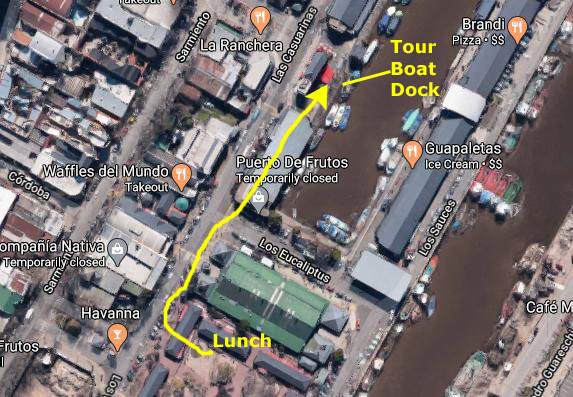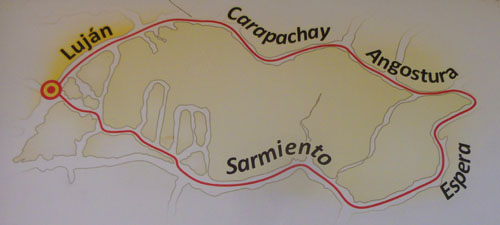


 |
December 6, 2019: A Day at Iguassu Falls |
 |
December 4, 2019: Walking Around Buenos Aires |
 |
Return to the Index for 2019 |
Today, Greg has arranged for a guided tour up to the town of Tigre. Tigre is an Argentinean town just north of the city of Buenos Aires. It’s a gateway to the rivers and wetlands of the vast Paraná Delta. The town’s old fruit harbor, the Puerto de Frutos, is now a busy craft market. We will return in the afternoon at which time Fred and I will get ready to head over to the airport for our flight to Foz du Iguacu ahead of a day at Iguassu Falls.
The Trip to Tigre
We were away from the apartment fairly early for our walk back down to Plaza Italia, on the west side of the Botanical Garden. Our tour guide had set up a meeting place for the group he would be taking to Tigre, and it was at a small coffee shop right beside Plaza Italia. We got there a bit early, and found our guide with just a tiny bit of difficulty. As it turned out, there were, if I recall correctly, four other people on the tour, so with the tour guide, that made eight of us.
|
|
|
We did pass, for a second time during our stay here, the Monument to the Carta Magna and Four Regions of Argentina- commonly referred to as the "Monument of the Spanish"- which was in the middle of Avenue Libertador not far from Plaza Italia. The monument was a donation from the Spanish community in celebration of the centenary of the Revolución de Mayo of 1810 (which marked the formal beginning of Argentina's independence from Spain). It was built entirely in bronze and Carrara marble. The sculpture was unveiled in 1927.
About an hour after we left Plaza Italia, we were getting off the express highway and making our way into the town of Tigre.
Tigre and Puertos de Frutos
Tigre (Spanish for "tiger") is situated in the north of Greater Buenos Aires, about twenty miles north of the city proper. Tigre lies on the Paraná Delta and is a tourist and weekend destination, reachable by bus and train services, including the scenic Tren de la Costa. It is the main city, seat of the Tigre Partido.
|
I thought it might be a good idea to orient you to this area of Argentina and Uruguay- this huge delta formed at the mouth of both the Paraná and Uruguay Rivers. I might have made the map at left cover more ground, but then Tigre would have gotten lost. Suffice it to say that the Parana, coming in from the northwest (and Iguassu Falls), splits into a number of separate channels, and actually the Lujan River, which is the northern boundary of Tigre, is one of those channels. The Uruguay River comes into the delta area from the north (and forms part of the boundary between Argentina and Uruguay.
Tigre is a tourist and weekend destination, and there is a scenic train from Buenos Aires. It's actually not far from the city, but we could tell that there aren't that many places to park anywhere near the boat docks and such, so I would think that coming up by train for the day would be preferable.

The Fruit Port is a small jetty on the banks of the Luján River in Tigre, next to which the fruit market is located. They owe their names to the fact that until the middle of the 20th century the fruit production of the Paraná Delta landed there. Subsequently, the port activities for delta fruit production moved to Buenos Aires itself.
|
|
Fruit production of the Delta has declined, and currently the only products of the islands that are sold in this market are the crafts of wicker and rattan furniture pine and honey from area beekeepers. The market also offers a wide variety of handicrafts and food products. There is still a food trade carried out by warehouse boats.
|
By the time we'd been let off at the port so our guide could park the vehicle in a tourist lot and he had rejoined us, it was coming up on eleven, and some of the food stalls were beginning to open up. As we would be leaving for a two-hour boat tour at twelve-thirty, our group decided to have a light lunch at one of the food stands our guide had recommended. It turned out to be quite good, and at left you can see almost all of our group eating meat pies and french fries.
|
So, the brief history of the Puerto de Frutos is: 1938- the fruit market starts operating in its current location; 1983- the municipality inaugurated the repurposing of the marked to an artisan fair; 2003- an official website for the Fruit Port is launched.
In addition to the crafts market and food stalls that operate here now, the Argentine Naval Museum is also nearby. Along with the nearby antiques shops, riverside restaurants and pubs, the casino, the Parque de la Costa, and the natural environment of Tigre (the adjacent delta) make this a tourist destination throughout the year.
|
|
|
We had plenty of time for lunch before our tour guide began shepherding us down to the middle dock area and the starting point for our boat tour of the Paraná Delta.
Our Boat Tour of the Paraná Delta
As I mentioned above, Tigre is also the starting point for visits to the Paraná Delta. Since there are no roads to speak of that really go into the delta, going up and down the various channels and river is the only way to see it.
|
 |
Bambi is one of a few companies we saw that operated tourist boats into the delta. Most of these boats, including ours, were actually vintage mahogany commuter launches; these are just about the only way to reach the houses that line the various waterways through the delta as there are no roads that traverse the delta at all.
When we got to the Bambi dock, where Fred took the picture above, left, our tour boat wasn't back from its previous run, so we had some time to take pictures. I made this panoramic view of this middle dock area:
 |
Out in the delta itself, as we would find, there are mostly just private houses that line most of the waterways, and each of these has a boat dock (or shares one). Oddly, we didn't see a lot of other boat traffic, nor did many of the docks we saw have boats tied up at them, which led me to believe that many of these houses are weekend places or used otherwise infrequently.
|
|
We only had to wait maybe fifteen minutes before our tour boat came up the aisle to turn and dock at the Bambi docking ramp. We had to wait for a few minutes for the previous passengers to disembark before we could get on, of course, but in just a couple of minutes we were walking down the ramp and stepping onto the craft.
We didn't want to hold up the people behind us (there were maybe thirty folks on our craft), so we couldn't take a great many pictures, so here is just the best one showing the inside of the tour boat. Pretty quickly, we were off on our boat tour of the Paraná Delta.
|
 |
When everyone was aboard, we pulled away from the dock to head up the canal to the Lujan River (actually a channel of the Parana River).
|
(Mouseover Image if Video Controls Not Visible) |
In this first movie, I did one continuous shot of our trip up the canal from the dock and out into the Lujan River where we turned to the north and headed alongside the town of Tigre. You can use the player at right to have a look.
While I was making my movie, Fred was taking some pictures of the boats along the canal, including one of a vintage craft like ours, and another of some more modern craft, including one of the two or three police boats that we saw today. And when we got to the river end of the canal, you can see the two restaurants that are on the river at the end of our dock and the one west of us. You can also see the amusement park west of us upriver, but we'll get some closer pictures of that in a moment.
I want to divide the tour into two sections, because they were completely different. In our short trip up the Lujan River, we were alongside the town of Tigre, and there were lots of different things to see- commercial shipping (both active and derelict), dwellings and mansions from the “Belle Époque” (again, well-kept-up to falling-into-disrepair), civic buildings and museums, small pensions and upscale lodges, and numerous restaurants, teahouses, and parks. The dividing line between civilization and the delta is stark; on the south side of the Lujan, development is complete, but on the north side- the delta side- there is at most a single row of buildings with the wild delta to the north of them.
|
 |
In addition to the still shots taken along the Lujan River, I made two movies that actually turned out pretty decent. In both of them, you'll get a chance to experience what it was like cruising along in this low-slung vintage craft, and in one of them, I'll try not to drop my camera in the water as I use the selfie stick to show us from the outside:
|
(Mouseover Image if Video Controls Not Visible) |
(Mouseover Image if Video Controls Not Visible) |
We continued up the Lujan River to the Carapachay Channel, where we turned right to head into the delta itself. You will recall from the diagram above that we are going to make a big circle through the Delta.
|
Motorboats are essential for travel through the inter-connecting rivers and streams here in the delta. Back at Tigre, one can find boats parked everywhere that are used by residents and vacationers in the delta. I assume that there are electric lines into the delta; the houses looked too big and too modern to be without that essential, and so I assume that Internet is probably available here, too.
But access is via the water. As we made our big circle, Fred and I (who were on opposite sides of the craft) took picture after picture of the houses and of scenes on the waterways. In the slideshow at left, I have tried to select a broad range of pictures, not only of the many different buildings that we saw but also of the waterways themselves. I know there are a lot of pictures in the show, but at least you can go through them quickly by clicking on the little arrows in the lower corners of each "slide".
I hope that the selection of pictures in the slideshow gave you a really good idea of what the Paraná delta is like for the people that either live here or have weekend/vacation homes here. Today was warm, but certainly not oppressive, but I did find myself wondering what it might be like here in the heat of the summer, which is still a month away, what with all the vegetation and water around.
To complete our tour through the delta, I want to include two movies here, taken on different waterways. Each will let you experience what it was actually like to motor through the Paraná delta:
|
(Mouseover Image if Video Controls Not Visible) |
(Mouseover Image if Video Controls Not Visible) |
After about 90 minutes, we came back south out of the Sarmiento River and back to the Lujan, where we jogged across that waterway to find the canal we would take back to our dock.
|
|
(Mouseover Image if Video Controls Not Visible) |
At the dock, we all disembarked and began to walk back to the Puerta de Frutos, on the way taking a couple of final pictures here:
|
|
If we had taken a lot of pictures on our return trip to the city, or if that route had been interesting enough to cover in detail, I might have created a section for these last pictures from our excursion. But since neither was true, I'll just include the best of the pictures taken on our return trip here:
|
|
|
We were dropped off back at Plaza Italia about four-thirty, and we walked back to the apartment.
At Jorge Newbery Airport/Our Flight to Foz du Iguacu
This evening, Fred and I are leaving from the local, in-town airport, on a flight to Foz du Iguacu, where we will check into a hotel this evening ahead of our all-day tour of Iguassu Falls tomorrow. I was able to get us a flight about eight o'clock, so we had plenty of time to relax, pack what we would need for the day, and then catch a cab to the airport.
Taxis are particularly cheap, I think, here in Buenos Aires; the fifteen-minute trip, door to door, was about $6. From my house to Love Field here at home would be about the same, but it's only three minutes and about two miles. I was lucky to get flights out of and back to Jorge Newbery, as using the International Airport would have been far less convenient and would have required two nights in Foz du Iguaco, not just one.
|
|
I hope you'll join us for our tour of Iguassu Falls tomorrow. It is on the next album page.
 |
December 6, 2019: A Day at Iguassu Falls |
 |
December 4, 2019: Walking Around Buenos Aires |
 |
Return to the Index for 2019 |